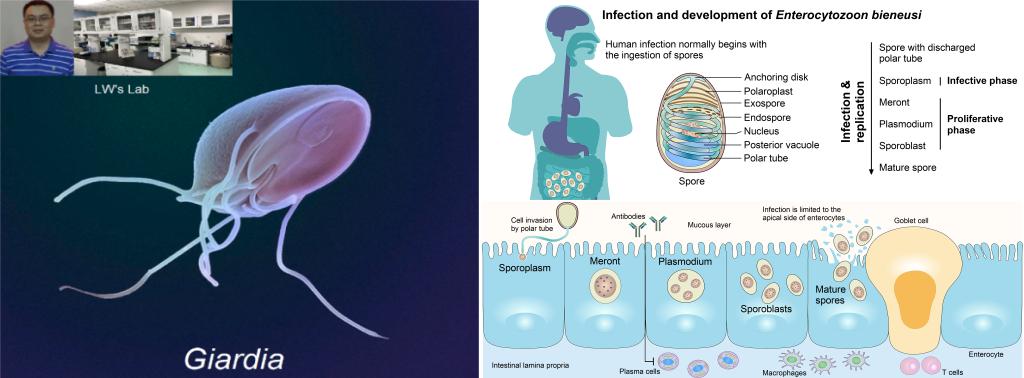
李巍,男;副院长,团队带头人,教授,博导;省优青/创新人才、校学术英才/教学名师.
邮箱:liwei@neau.edu.cn & neaulw@gmail.com.
主页:http://orcid.org/0000-0002-4264-1864 & https://publons.com/researcher/2626269.
编辑:Front Microbiol杂志: Associate Editor;Parasitologia杂志: Editor
研究方向:人兽共患原虫跨物种传播及与宿主互作和致病机制.

教育与工作经历:
2021.04- Present: 东北农业大学 “兽医寄生虫学”一流学科团队带头人
2020.10- Present: 东北农业大学 副院长
2016.09- Present: 东北农业大学 教授/博士生导师
2017.11-2018.11: 德国埃朗根-纽伦堡大学 访问学者
2012.01-2016.09: 东北农业大学 引进人才/副教授/硕士生导师
2009.10-2011.10: 美国疾病预防控制中心 联培博士
2006.09-2011.12: 吉林大学 博士学位
2002.09-2006.06: 华中农业大学 学士学位
科研项目:
主持国家自然科学基金面上和青年项目、省优秀青年基金、教育部博士点基金、省自然科学基金、中国博士后基金在内的国家级、省部级和厅局级课题18项。参加完成科技部“十一/二/三五”科技支撑计划项目、“973”和“863”计划项目等多项课题。
科研论文和著作:
发表第一或通讯署名SCI论文40篇(2009至2022),其中TOP期刊论文16篇,国际合作论文16篇,3篇为ESI高被引/研究前沿/热点论文(非自引,其中2篇单篇引用>100次),论文发表在Trends Parasitol、J Clin Microbiol、One Health、Appl Environ Microbiol、PLoS Negl Trop Dis、Int J Parasitol、Infect Immun等微生物学及寄生虫学领域著名期刊上; 主参编十一/二/三五国家规划教材8部。
代表性论著:
病原与宿主互作及致病机制
1. Zhao Y, Yang Y, Liu M, Qin X, Yu X, Zhao H, Li X, Li W*. 2022. COX-2 is required to mediate crosstalk of ROS-dependent activation of MAPK/NF-κB signaling with pro-inflammatory response and defense-related NO enhancement during challenge of macrophage-like cell line with Giardia duodenalis. PLoS Negl Trop Dis 16:e0010402.
2. Yang Y, Zhao Y, Liu L, Zhu W, Jia S, Li X, Li W*. 2022. The anti-apoptotic role of COX-2 during in vitro infection of human intestinal cell line by Giardia duodenalis and the potential regulators. Infect Immun 90:e0067221.
3. Liu M, Yang Y, Zhu W, Wu J, Yu X, Li W*. 2023. Specific TLR-mediated HSP70 activation plays a potential role in host defense against the intestinal parasite Giardia duodenalis. Front Microbiol 14:1120048. (Invited)
4. Liu L, Yang Y, Fang R, Zhu W, Wu J, Li X, Patankar JV, Li W*. 2021. Giardia duodenalis and its secreted PPIB trigger inflammasome activation and pyroptosis in macrophages through TLR4-induced ROS signaling and A20-mediated NLRP3 deubiquitination. Cells 10:3425. (International Co-authored)
5. Liu L, Wei Z, Fang R, Li X, Li W*. 2020. Giardia duodenalis induces extrinsic pathway of apoptosis in intestinal epithelial cells through activation of TNFR1 and K63 de-ubiquitination of RIP1 in vitro. Microb Pathog 149:104315.
6. Liu L, Fang R, Wei Z, Wu J, Li X, Li W*. 2020. Giardia duodenalis induces apoptosis in intestinal epithelial cells via reactive oxygen species-mediated mitochondrial pathway in vitro. Pathogens 9:693. (Editors’ Choice)
7. Patankar JV, Muller TM, Kantham S, Acera MG, Mascia F, Scheibe K, Mahapatro M, Heichler C, Yu Y, Li W, Ruder B, Gunther C, Leppkes M, Mathew MJ, Wirtz S, Neufert C, Kuhl AA, Paquette J, Jacobson K, Atreya R, Zundler S, Neurath MF, Young RN, Becker C. 2021. E-type prostanoid receptor 4 drives resolution of intestinal inflammation by blocking epithelial necroptosis. Nat Cell Biol 23:796-807. (International Co-authored)
8. Patankar JV, Chiriac M, Lehmann M, Kuhl AA, Atreya R, Gonzalez-Acera M, Schmitt H, Gamez-Belmonte R, Mahapatro M, Diemand L, Hartmann L, Mascia F, Hracsko Z, Thonn V, Schodel L, Zielinska M, Yu Y, Erkert L, Li W, Zeitler M, Ruder B, Ganzleben I, Gunther C, Voehringer D, Zundler S, Neurath MF, Siegmund B, Becker C*. 2020. Severe acute respiratory syndrome coronavirus 2 attachment receptor angiotensin-converting enzyme 2 is decreased in Crohn's disease and regulated by microbial and inflammatory signaling. Gastroenterology. 160: 925-928 e4. (International Co-authored)
9. Yu YQ, Zielinska M, Li W, Bernkopf DB, Heilingloh CS, Neurath MF, Becker C*. 2020. PGAM5-MAVS interaction regulates TBK1/IRF3 dependent antiviral responses. Sci Rep 10:8323. (International Co-authored)
跨物种传播及适应机制
1. Li W, Feng Y, Santin M*. 2019. Host specificity of Enterocytozoon bieneusi and public health implications. Trends Parasitol 35:436-451. (Cell Press, ESI HOT/Research Front, Cited 176 times in Google Scholar, International Co-authored)
2. Li W, Feng Y*, Xiao L*. 2022. Enterocytozoon bieneusi. Trends Parasitol 38:95-96. (Cell Press, Parasite of the Month)
3. Li W*, Xiao L*. 2021. Ecological and public health significance of Enterocytozoon bieneusi. One Health 12:100209. (Perspective, ESI Highly Cited/Research Front)
4. Li W*, Xiao L*. 2019. Multilocus sequence typing and population genetic analysis of Enterocytozoon bieneusi: host specificity and its impacts on public health. Front Genet 10:307. (Theory)
5. Li W*, Feng Y, Zhang L, Xiao L*. 2019. Potential impacts of host specificity on zoonotic or interspecies transmission of Enterocytozoon bieneusi. Infect Genet Evol 75:104033. (Invited)
6. Li W*, Feng Y, Xiao L*. 2020. Diagnosis and molecular typing of Enterocytozoon bieneusi: the significant role of domestic animals in transmission of human microsporidiosis. Res Vet Sci 133:251-261. (Invited)
7. Wan Q, Xiao L, Zhang X, Li Y, Lu Y, Song M, Li W*. 2016. Clonal evolution of Enterocytozoon bieneusi populations in swine and genetic differentiation in subpopulations between isolates from swine and humans. PLoS Negl Trop Dis 10:e0004966. (International Co-authored)
8. Yang J, Song M, Wan Q, Li Y, Lu Y, Jiang Y, Tao W, Li W*. 2014. Enterocytozoon bieneusi genotypes in children in northeast China and assessment of risk of zoonotic transmission. J Clin Microbiol 52:4363-7.
9. Li W, Kiulia NM, Mwenda JM, Nyachieo A, Taylor MB, Zhang X, Xiao L*. 2011. Cyclospora papionis, Cryptosporidium hominis, and human-pathogenic Enterocytozoon bieneusi in captive baboons in Kenya. J Clin Microbiol 49:4326-9. (International Co-authored)
10. Jiang Y, Tao W, Wan Q, Li Q, Yang Y, Lin Y, Zhang S, Li W*. 2015. Zoonotic and potentially host-adapted Enterocytozoon bieneusi genotypes in sheep and cattle in northeast China and an increasing concern about the zoonotic importance of previously considered ruminant-adapted genotypes. Appl Environ Microbiol 81:3326-35.
11. Li W*, Li Y, Song M, Lu Y, Yang J, Tao W, Jiang Y, Wan Q, Zhang S, Xiao L*. 2015. Prevalence and genetic characteristics of Cryptosporidium, Enterocytozoon bieneusi and Giardia duodenalis in cats and dogs in Heilongjiang province, China. Vet Parasitol 208:125-34. (ESI Highly Hot/Research Front, Cited 120 times in Google Scholar, International Co-authored)
12. Li W, Cama V, Feng Y, Gilman RH, Bern C, Zhang X, Xiao L*. 2012. Population genetic analysis of Enterocytozoon bieneusi in humans. Int J Parasitol 42:287-93. (International Co-authored)
13. Li W, Cama V, Akinbo FO, Ganguly S, Kiulia NM, Zhang X, Xiao L*. 2013. Multilocus sequence typing of Enterocytozoon bieneusi: lack of geographic segregation and existence of genetically isolated sub-populations. Infect Genet Evol 14:111-9. (International Co-authored)
14. Zhu W, Tao W, Gong B, Yang H, Li Y, Song M, Lu Y, Li W*. 2017. First report of Blastocystis infections in cattle in China. Vet Parasitol 246:38-42.
15. Li W*, Wan Q, Yu Q, Yang Y, Tao W, Jiang Y, Xiao L*. 2016. Genetic variation of mini- and microsatellites and a clonal structure in Enterocytozoon bieneusi population in foxes and raccoon dogs and population differentiation of the parasite between fur animals and humans. Parasitol Res 115:2899-904. (International Co-authored)

